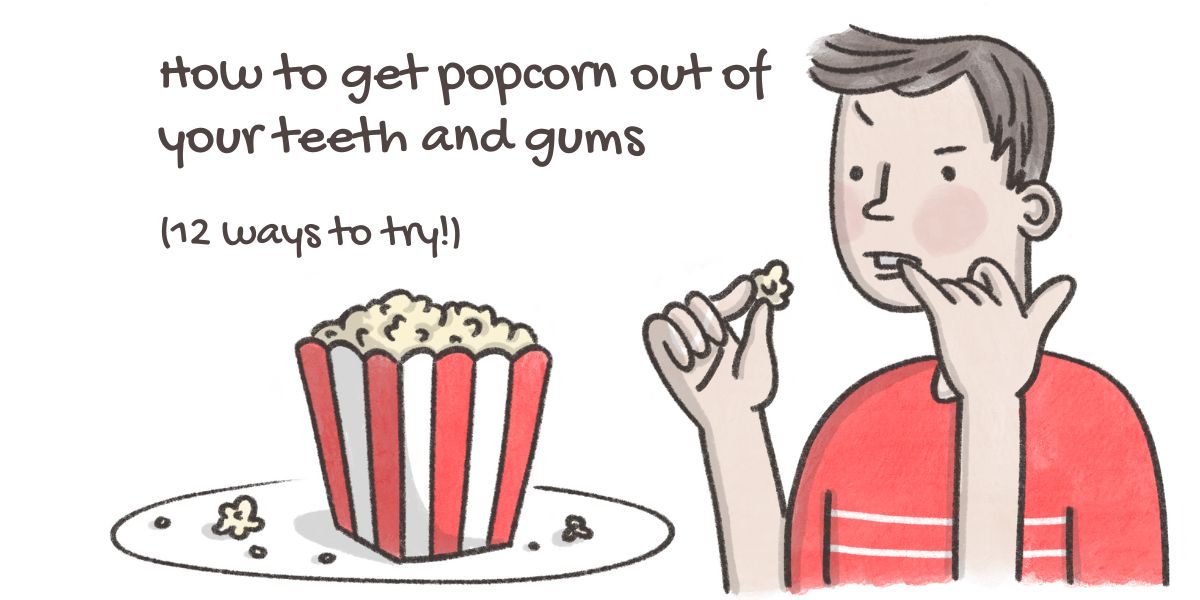If you’ve ever had the unfortunate experience of getting popcorn stuck in your teeth or a popcorn shell stuck in gum, you know it can be a real pain to get out.
There are a few tricks that can help if you have popcorn stuck in your gums and teeth and we’ve even got pictures to show you.
12 Ways to get Popcorn Out of Gums and Teeth
(Also how to get popcorn kernels out of gums too!)
- Use floss
- Use an interdental brush
- Use a toothpick
- Use a water pic (water flosser)
- Use a sulca brush
- Use an electric toothbrush
- Use a soft bristle manual toothbrush
- Use a Monoject syringe
- Chew gum
- Use your tongue
- Rinse your mouth with salt water for 60 seconds
- Visit your dentist
Use Floss to Remove the Popcorn from your Teeth and Gums
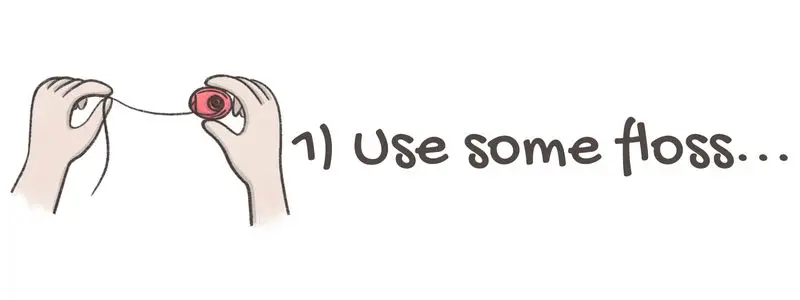
Flossing is an important part of oral hygiene, and it’s especially important after eating popcorn. The American Dental Association recommends flossing at least once a day to remove plaque and bacteria from teeth and gums.
When it comes to popcorn, flossing is the best way to remove the small pieces of kernels that can get stuck between teeth.
To floss effectively, use a piece of floss that is about 18 inches long. Wrap most of the floss around your middle finger, leaving just a few inches to work with. Gently insert the floss between your teeth and move it up and down against the side of each tooth. Use a light back-and-forth motion to remove the popcorn.
When you’re finished, throw away the used floss and rinse your mouth with water. With regular flossing, you can keep your teeth and gums healthy – and avoid having to pick popcorn out of your teeth!
Use an Interdental Brush
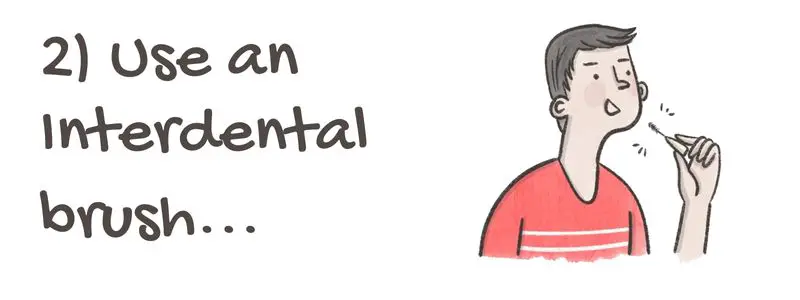
An interdental brush is a small, handheld brush that can be used to clean the spaces between teeth. These brushes are designed to reach places that regular toothbrushes and floss can’t.
To use an interdental brush, insert the brush between your teeth and move it back and forth to remove the popcorn from your teeth and gums.
Be very careful when using an interdental brush to avoid piercing your gums with the tip of the brush.
Use a Toothpick
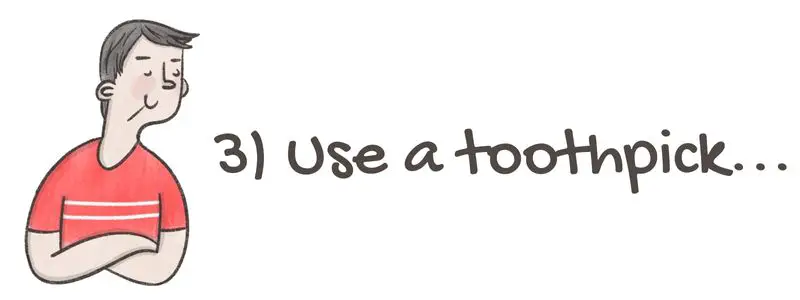
A toothpick is a thin, pointed piece of wood or plastic that can be used to remove food from teeth.
To use a toothpick, insert the point of the pick between your teeth and gently scrape it along the gum line to remove the popcorn from your teeth and gums. You need to be careful when using a toothpick as they have a sharp pointed tip that can damage your gums.
Use a WaterPik (Water Flosser)
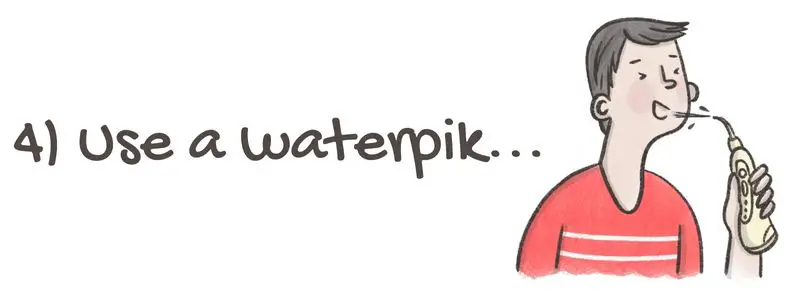
A water flosser, also known as a waterpik, is a small, handheld device that uses a stream of water to remove plaque and bacteria from teeth and gums.
To use a water flosser, fill the reservoir with water and insert the tip of the flosser between your teeth. Turn on the device and direct the water stream against each tooth’s side to remove the popcorn from your teeth and gums. With most water flossers, you can adjust the power of the flow. Start with low pressure and slowly increase it until the popcorn is removed.
Use a Sulca Brush
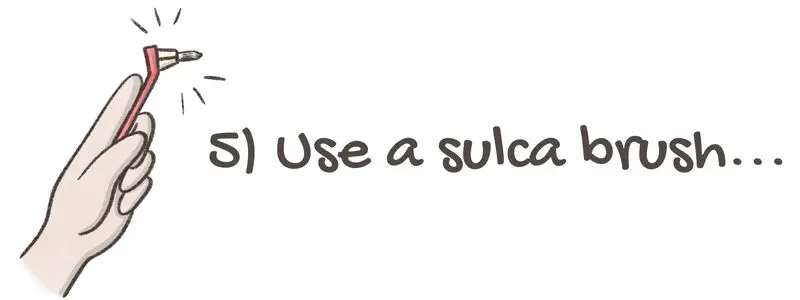
A sulca brush is a small, handheld brush that can be used to clean the spaces between teeth. Sulca brushes are available at most supermarkets, pharmacies, and online.
To use a sulca brush, insert the brush between your teeth and move it back and forth to remove the popcorn from your teeth and gums.
Use an Electric Toothbrush
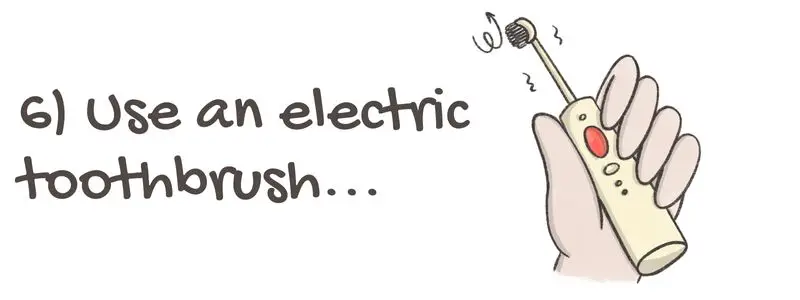
An electric toothbrush is a small, handheld device that uses a rotating head to remove plaque and bacteria from teeth and gums. Electric toothbrushes are far more effective at cleaning your teeth and gums than manual brushes.
To use an electric toothbrush to remove popcorn, place the brush at a 45-degree angle to your teeth and gums. Make sure that the brush is half on your gums and half on your teeth. Use a light circular motion to brush the popcorn away.
Use a Soft Bristle Manual Toothbrush
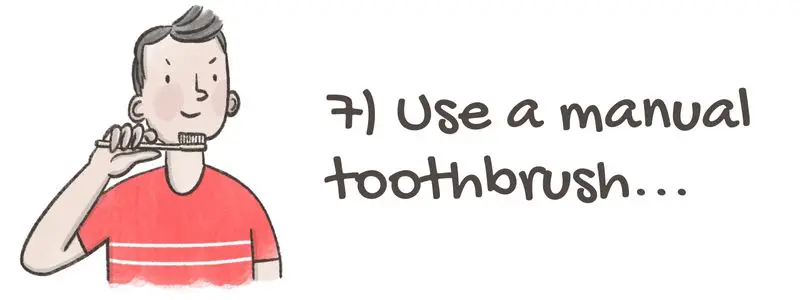
A manual toothbrush is a small, handheld brush that uses bristles to remove plaque and bacteria from teeth and gums.
To use a manual toothbrush, wet the bristles of the brush and place the brush at a 45-degree angle to your teeth and gums. Use a light circular motion to brush the popcorn away.
Use a Monoject Syringe
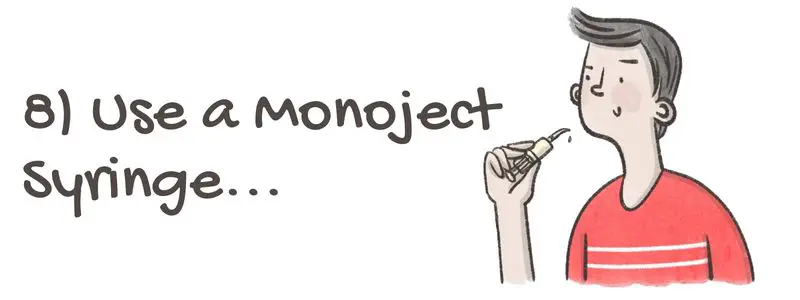
A Monoject syringe is a small, handheld device that uses a stream of water to remove plaque and bacteria from teeth and gums.
Monoject syringes are available from your dentist or on Amazon.
To use a Monoject syringe, fill the reservoir with warm water or salt water and gently squirt the water at the stuck popcorn. The water will loosen the popcorn and allow you to remove it from your teeth and gums.
Chew Gum
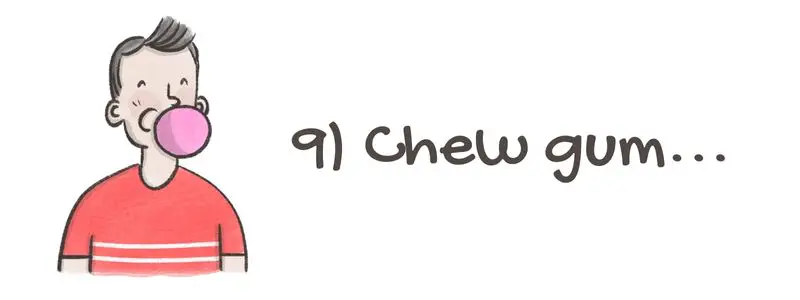
Chewing gum can help remove popcorn from your teeth and gums. The chewing action will help to loosen the popcorn and make it easier to remove.
Choose a sugar-free gum to avoid adding cavity-causing sugar to your mouth.
Always dispose of your chewing gum carefully! There is nothing worse than standing on gum that’s stuck to the sidewalk!
Use Your Tongue
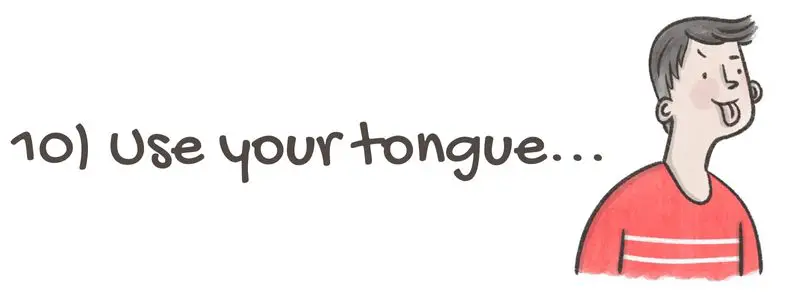
Your tongue is a powerful tool that can help remove popcorn from your teeth and gums. The motion of your tongue will help to loosen the popcorn and make it easier to remove. Using your tongue can be particularly good at removing a popcorn kernel stuck in gum behind your tooth.
To use your tongue, press the tip against the popcorn and wiggle it around. The movement will help to loosen the popcorn and make it easier for you to remove it.
Spit the popcorn into the tissue and rinse your mouth with water to remove any popcorn that is left behind. Repeat the process until all of the popcorn is removed from your teeth and gums.
Rinse your Mouth with Saltwater for 60 Seconds
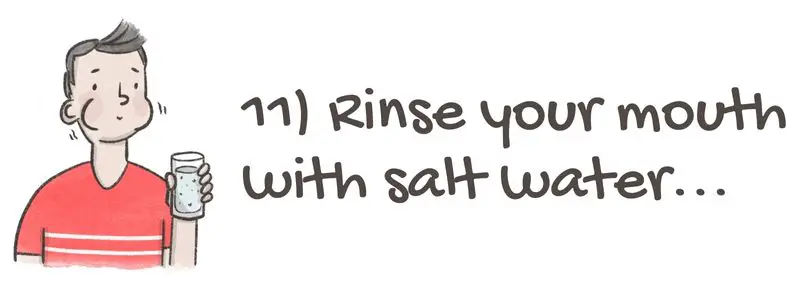
Saltwater is a natural disinfectant that can help to remove bacteria from your mouth. Rinse your mouth with salt water for 60 seconds to remove any popcorn that is left behind, being sure to swish the water where the popcorn is stuck.
TIP – Add 1 teaspoon of salt to 8 ounces of warm water to make salt water. Stir until the salt is dissolved, and swish the solution around your mouth for 60 seconds. Spit the salt water into the sink and rinse your mouth with water to remove any leftover salt.
Visit your Dentist
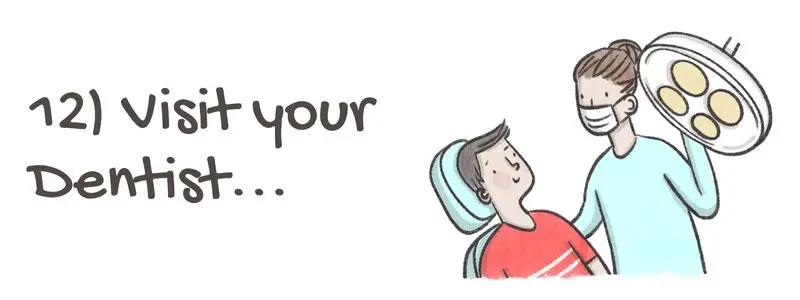
If you end up with a popcorn kernel stuck in gums for days, weeks or months and are unable to remove it using the methods above, visit your dentist. Your dentist will be able to remove the popcorn and give you advice on how to avoid getting popcorn stuck in your teeth in the future.
Preventing Popcorn From Getting Stuck in Your Teeth
You might be wondering how to eat popcorn without getting kernels in your teeth so you can avoid having to remove the pesky kernels altogether. Good news! There are a few things that you can do to prevent popcorn from getting stuck in your teeth:
Chew Slowly and Carefully
Chewing slowly gives you time to notice when a piece of popcorn is about to get stuck in your teeth. You can then remove the popcorn before it has a chance to become lodged.
Avoid Hard Pieces: Inspect Each Piece of Popcorn
Before you put it in your mouth, if there are any hard pieces, remove them so they don’t get stuck in your teeth. You’ll also want to avoid hard kernels, which can crack and damage your teeth.
Can Popcorn Kernels Cause Gum Infection?
Unfortunately, yes, popcorn can cause gum infection. The kernels can cut your gums and cause them to bleed and, in the worst case, can cause pockets within which bacteria can multiply. If this happens, you risk developing an infection, which can lead to a dental abscess.
Removing any popcorn stuck in your teeth and gums as quickly as possible is always best.
How do I Get a Popcorn Kernel out of my Teeth Without Flossing?
You can remove popcorn without flossing. Try using a toothpick, interdental brush, soft toothbrush or gargling with salt water. If you don’t have either of those, try using your tongue or chewing gum. If all else fails, visit your dentist.
What Can I Use Instead of Floss to Get Popcorn out of my Teeth?
There are a few things you can use:
If all else fails, visit your dentist.
How do you get Popcorn out of Wisdom Teeth Gaps?
You can get popcorn out of wisdom teeth holes similar to how you remove it from your teeth and gums. Interdental brushes, toothpicks, waterpicks, and soft bristle toothbrushes effectively remove food particles, including popcorn, from your wisdom teeth holes.
For more info on popcorn and tooth extraction, check our full guide.
Will a Popcorn Kernel Work its Way Out of Gums?
A popcorn kernel may eventually work out of your gums, but it can take days or weeks. Additionally, the kernel can cut your gums and cause an infection. Removing the kernel as soon as possible is always best to avoid these complications.
Saliva does not break down popcorn kernels making it unlikely that it will dislodge itself over time.
Can I Leave a Popcorn Kernel in my Gum?
No, you should not leave a popcorn kernel in your gum. As mentioned above, the kernel can cut your gums and cause an infection. It’s always best to remove the kernel as soon as possible.
If the kernel is stuck and you are unable to remove it, visit your dentist. They will be able to safely remove the kernel and give you advice on how to avoid getting popcorn stuck in your teeth in the future.
Curious to know if a popcorn kernel will dissolve?
Can Popcorn Cause Swollen Gums?
Yes, popcorn can cause swollen gums. The kernels can cut your gums and cause them to bleed. This can lead to an infection, which in turn can cause your gums to swell.
What to Do if you Get a Popcorn Kernel Stuck in the Roof of Your Mouth
If you get a popcorn kernel stuck in the roof of your mouth, use your tongue to push it to the front of your mouth so you can remove it with your fingers or a toothpick. If you are unable to remove it, visit your dentist.
FAQs Get Popcorn Out of Teeth and Gums
Why does popcorn get stuck in teeth and gums?
Popcorn hulls, also known as the outer shell, can get lodged between teeth or in the gums due to their small size and shape. The fibrous nature of popcorn can make it more likely to get trapped in dental crevices.
How can I prevent popcorn from getting stuck in my teeth and gums?
Chewing carefully and slowly can help reduce the chances of popcorn getting stuck. You can also consider flossing or using an interdental brush after consuming popcorn to remove any remnants.
What should I do if popcorn gets stuck in my teeth or gums?
If popcorn gets stuck, try using gentle measures to dislodge it. Start by rinsing your mouth with warm water, swishing it around to help loosen the popcorn. You can also try using dental floss or an interdental brush to gently remove the stuck popcorn.
Is it safe to use toothpicks to remove popcorn from teeth and gums?
Toothpicks can be used with caution to remove popcorn stuck between teeth. However, it is essential to use them gently and avoid excessive force that may damage gums or cause injury.
Can I use mouthwash to remove popcorn stuck in my teeth?
Mouthwash alone may not effectively remove popcorn from teeth or gums. However, rinsing with mouthwash after using other methods can help flush out any remaining particles and provide a fresh feeling.
What if I can’t remove the popcorn stuck in my teeth or gums?
If you are unable to remove the stuck popcorn using home remedies, it is recommended to seek professional dental assistance. Dentists have the necessary tools and expertise to safely remove trapped popcorn and address any potential issues.
How can I prevent discomfort or irritation from popcorn getting stuck?
Maintaining good oral hygiene practices, such as regular brushing and flossing, can help prevent discomfort or irritation caused by trapped popcorn. If you frequently experience difficulty with popcorn, consider consuming alternative snacks that are less likely to get stuck.
Should I be concerned about potential dental issues caused by popcorn getting stuck?
While getting popcorn stuck occasionally may not lead to significant dental issues, repeated instances of trapped popcorn can potentially cause gum irritation, inflammation, or even dental decay. It’s important to address the issue promptly and practice preventive measures.
Can I still enjoy popcorn if I frequently get it stuck in my teeth?
If you frequently encounter problems with popcorn getting stuck, consider making adjustments in your popcorn consumption habits. Opt for alternatives like air-popped popcorn, which tends to have fewer hulls, or try different snacks that are less likely to get trapped in dental crevices.
Remember, if you have persistent issues or concerns related to popcorn getting stuck in your teeth or gums, it is advisable to consult with a dental professional for personalized guidance and assistance.
Final thoughts 💭
Popcorn is a delicious snack, but it can harm your teeth and gums if not removed properly. Following this post’s simple steps, you can enjoy popcorn without worrying about the negative consequences. So go ahead and pop some corn- just ensure you take care of your pearly whites afterward!
Sources
https://www.drjosephperry.com/4-dental-issues-associated-with-popcorn-kernels
https://southmountainfamilydental.com/how-do-you-get-a-popcorn-kernel-out-of-your-gums/
https://www.mytoothbetold.com/10-ways-how-to-get-a-popcorn-kernel-out-of-your-gums/

